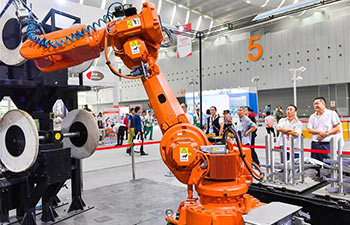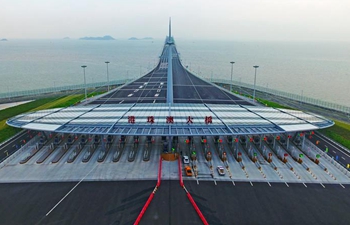NAIROBI, Oct. 27 (Xinhua) -- Jerusha Atieno sells vegetables in Soweto, Kayole, a low income suburb on the east of Kenya's capital Nairobi.
Her average income a day is no more than 5 U.S. dollars. Therefore, she buys items in small quantities.
Initially, she would buy all her household items from small shops near her home, but these days, even when she wants to buy salt, Atieno walks to any of the three malls not far from her shanty home.
"I can walk either to Shujaa Mall, which is the nearest or Greenspan Mall or Komarock Mall, which is a little far but still a walking distance," she said on Friday.
All the malls, located near the surrounding middle income estates of Umoja, Savannah, Komarock, Greenspan and Jacaranda, host Kenya's leading supermarkets.
Inside the malls, Atieno can walk around as she looks at the items on display, eat at a restaurant, visit a bank or enter an Ethiopian food eatery or a coffee shop, before buying what she wants at the supermarket.
And to cap it all, she has a shopping card through which she earns points every time she shops, which she can then redeem later.
"I never imagined I would ever shop like this. This is something I only saw in Nigerian movies or in places where the rich live in Nairobi one time I was doing domestic work there but now it has come to us," said the happy trader.
Initially, the malls were constructed in leafy suburbs in Nairobi and were mainly frequented by the rich and the sophisticated.
But things changed in the last five years or so as developers in the East African nation took the shopping complexes to the middle-income suburbs.
Bordering the middle-income estates are low income settlements, including slums.
The malls have spiced up shopping experiences for the residents in the suburbs, especially the low income earners.
Some of the suburbs in Nairobi and on the outskirts where malls have been constructed recently are Roysambu, Ruaka, Kitengela, Syokimau, Athi River, Buru Buru and Rongai.
The low income earners frequent the malls as much as the high earners.
While the former might only strict themselves to supermarkets, the latter enjoy top services at health clinics, banks and exclusive boutiques.
"I no longer buy things like bread from the shop near my home. These days I park my bike near the entrance of the mall and go for shopping," said John Njenga, a motorbike rider in Kitengela.
A new mall was opened two weeks ago in the fast-growing suburb and it hosts a supermarket and various other shops, with low income earners like Njenga flocking the building to shop.
According to a Consumer Insight survey released online recently, Kenyan's love for shopping is huge, only second in Africa after South Africa. They are then followed by Nigeria and Ghana, with people flocking malls in their hundreds every day.
Earnest Manuyo, a business management lecturer at Pioneer Institute in Nairobi, noted that the malls have not only bettered the shopping experience for the poor but also the middle-income.
"They are game-changer. People are enjoying quality shopping from near their homes," he said.
For the middle-income, he noted that during weekend, they can shop as their children enjoy bouncing castles, face painting or ride trains.
"It is really new and memorable experience for some middle and low income earners," he said.













